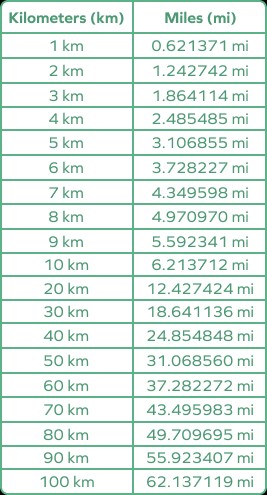Kilometers and miles, two units of length, are used globally to measure distances, but they come from different measurement systems and are not equal in length. Understanding the relationship between them, and how to convert from one to the other, is essential in a world where both metric and imperial systems are still in use. This article will delve into a detailed comparison of kilometers and miles, providing you with the formulas, steps, and examples you need to master kilometer to mile conversion.
Defining Kilometers and Miles
To truly understand the comparison, let’s define each unit individually.
What is a Kilometer (km)?
The kilometer (km) is a unit of length in the metric system, the international standard for measurement. It’s used extensively around the world for measuring geographic distances, road lengths, and in various scientific contexts. The prefix “kilo-” indicates one thousand, so:
1 kilometer = 1,000 meters
Meters, in turn, are based on the speed of light, making the kilometer a unit grounded in fundamental physics. Kilometers are part of the International System of Units (SI), which promotes standardization and ease of use in science and trade globally.
What is a Mile (mi)?
The mile, on the other hand, is a unit of length primarily used in the United States, the United Kingdom, and a few other countries that historically used the British Imperial system. There are different definitions of a mile throughout history, but the statute mile is the standard mile used today for land distances in these countries.
1 mile = 5,280 feet
The mile has historical roots tracing back to the Roman mile (“mille passus,” meaning “thousand paces”). This historical lineage explains why it’s not as neatly tied to decimal-based systems like the metric kilometer.
Key Differences Between Kilometers and Miles
While both units measure distance, several key differences set them apart:
- System of Measurement: Kilometers belong to the metric system, a decimal-based system, while miles are part of the imperial/US customary system. This fundamental difference impacts how conversions and calculations are handled.
- Global Usage: Kilometers are used by the vast majority of countries worldwide. Miles are predominantly used in the United States and the UK. This geographical difference is crucial when traveling or dealing with international measurements.
- Length: A mile is longer than a kilometer. As we will explore in detail, approximately 1 mile is equal to 1.609 kilometers. This difference is significant when estimating distances or understanding speed measurements.
- Ease of Conversion: The metric system’s decimal base makes conversions within the system (e.g., kilometers to meters) straightforward, involving powers of 10. Conversions involving miles and other imperial units are often less intuitive due to the lack of a consistent decimal base.
Kilometer to Mile Conversion Formula and Steps
Converting kilometers to miles, or vice versa, is a common need. Here are the formulas and steps for accurate conversion:
Formula to Convert Kilometers to Miles
The precise conversion factor is:
1 kilometer = 0.621371 miles
To convert any distance in kilometers to miles, you multiply the distance in kilometers by this conversion factor:
Distance in miles = Distance in kilometers × 0.621371
For practical purposes, you can often use a simplified approximation:
1 kilometer ≈ 0.62 miles
This approximation is reasonably accurate for everyday estimations.
Step-by-Step Conversion Process
Let’s outline the steps to convert kilometers to miles:
Step 1: Identify the distance in kilometers that you want to convert.
Step 2: Multiply this distance by the conversion factor 0.621371 (or the approximation 0.62 for less precise needs).
Step 3: The result is the equivalent distance in miles.
Example: Convert 10 kilometers to miles.
Distance in miles = 10 km × 0.621371 = 6.21371 miles
Therefore, 10 kilometers is approximately equal to 6.21 miles.
Using Division for Conversion: An Alternative Approach
Another way to think about the conversion is to use division, based on the relationship:
1 mile ≈ 1.609 kilometers
To convert kilometers to miles using division, you would divide the distance in kilometers by 1.609 (or the approximation 1.6):
Distance in miles = Distance in kilometers / 1.609
Using the same example of 10 kilometers:
Distance in miles = 10 km / 1.609 ≈ 6.21 miles
Both multiplication and division methods will give you similar results, especially when using the more precise conversion factor.
Kilometer to Mile Conversion Table
For quick reference, here is a conversion table showing common kilometer values and their mile equivalents:
| Kilometers (km) | Miles (mi) |
|---|---|
| 1 | 0.62 |
| 5 | 3.11 |
| 10 | 6.21 |
| 20 | 12.43 |
| 50 | 31.07 |
| 100 | 62.14 |
| 500 | 310.69 |
| 1000 | 621.37 |


Alt text: Kilometer to mile conversion table showing equivalents for common distances.
This table provides a handy lookup for common conversions and can help you develop a better intuitive sense of the relationship between kilometers and miles.
Why Miles and When Are They Preferred?
Despite the global prevalence of the metric system, miles remain the standard unit for distance in certain contexts, especially in the United States and the UK. Here’s why:
- Historical Legacy: The mile is deeply ingrained in the culture and infrastructure of these countries. Road signs, speed limits, and maps are all traditionally in miles.
- Practicality in Certain Contexts: Some argue that miles are more practical for everyday distances at a human scale. For instance, miles might feel more relatable when describing distances for driving or running in countries where it’s the standard.
- Speed and Time Relation: As mentioned in the original article, at approximately 60 miles per hour, you travel one mile per minute. This creates an easy mental calculation for estimating travel times based on distance in miles.
However, it’s important to recognize that the global trend is towards metrication. In many countries that historically used imperial units, there’s been a partial or complete shift towards using kilometers in education, science, and even some everyday applications.
Interesting Facts About Miles
The mile has a rich history. Here are some interesting facts:
- Roman Origins: As mentioned, the term “mile” originates from the Roman “mille passus,” meaning a thousand paces. This reflects how distance was measured in ancient times – by counting steps.
- Variations in Mile Length: Historically, there have been different lengths for a mile in various regions and time periods. The statute mile, the standard today, was standardized in England in 1593. Other miles, like the nautical mile (used in sea and air navigation), still exist and have different lengths.
- Cultural Significance: The mile is deeply embedded in English language and culture, appearing in countless idioms, songs, and literary works. Phrases like “mile marker,” “go the extra mile,” and “miles to go before I sleep” illustrate its cultural presence.
Solved Examples for Kilometer to Miles Conversion
Let’s solidify your understanding with some practical examples:
Example 1: Convert 5 kilometers to miles.
Solution:
Distance in miles = 5 km × 0.621371 = 3.106855 miles
Approximately, 5 kilometers is about 3.11 miles.
Example 2: A marathon race is approximately 42.195 kilometers long. How long is it in miles?
Solution:
Distance in miles = 42.195 km × 0.621371 = 26.2187 miles
Thus, a marathon is approximately 26.22 miles long. This is the origin of the standard 26.2-mile marathon distance.
Example 3: If you drive 80 kilometers per hour, what is your speed in miles per hour?
Solution:
Speed in mph = 80 km/h × 0.621371 = 49.70968 mph
So, 80 kilometers per hour is approximately 49.71 miles per hour.
Example 4: Sarah is planning a 15 km hike. How far is this in miles?
Solution:
Distance in miles = 15 km × 0.621371 = 9.320565 miles
Sarah’s hike is about 9.32 miles.
Example 5: Convert 320 kilometers to miles.
Solution:
Distance in miles = 320 km × 0.621371 = 198.83872 miles
Therefore, 320 kilometers is equal to approximately 198.84 miles.
Conclusion: Kilometers vs. Miles – Understanding the Difference
Kilometers and miles are both units of distance, but they belong to different measurement systems and have different lengths. While kilometers are part of the globally accepted metric system, miles remain in use primarily in the United States and the UK due to historical and cultural reasons.
Understanding how to convert between kilometers and miles is crucial for anyone dealing with international travel, science, or simply needing to bridge the gap between these two measurement systems. Whether you’re planning a trip, tracking your fitness, or just curious about distances in different parts of the world, knowing the “Kilometer Compared To A Mile” relationship and conversion methods will prove invaluable. Remember, a mile is longer than a kilometer, and the conversion factor of approximately 0.62 (km to miles) or 1.609 (miles to km) will help you navigate between these units with ease.

